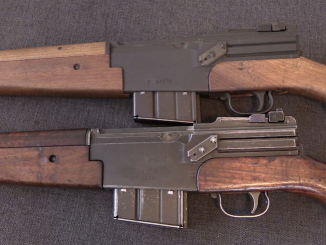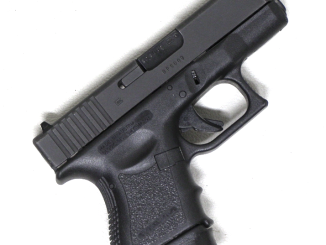Preorders now open for my book, Chassepot to FAMAS: French Military Rifles 1866-2016! Get your copy here!
The French Navy chose not to adopt the Gras rifle, and continued to use the paper-cartridge, needlefire Chassepot into the late 1870s. When they finally decided to adopt a new metallic-cartridge rifle, they decided to jump right to a repeater. Testing was done in 1877 of the Winchester-Hotchkiss, Krag-Petersen, and Kropatschek, and the Kropatschek was the winner. As the Navy did not need very many rifles, it opted to buy them directly from the Werndl factory in Steyr (Austria), which owned the rights to the system. An order for 25,000 was placed in 1878 and deliveries were completed in 1881.
This rifle was designated the Model 1878 Marine (ie, Navy), and it was chambered for 11mm Gras with a 7-round tube magazine. They were delivered polished in the white, as naval small arms often were at the time. While limited in number, these rifles would see widespread service in French colonies, and would also form the basis for development of the French-build model 1884 rifles – which we will cover in the next video.




Cracking video. Such an interesting rifle. Here’s a real geek question. Most of the Chilean M1886 Mannlicher rifles (also made by Steyr) are marked with an italic IIQ (“2Q”) mark . Here we have a rifle marked “2 Classe”. Are they saying the same thing? – I’ve read that it means “not good enough for the Austrian military but close enough”. And just to make it worse, I note some parts of the rifle have a “K” marking, which I’ve read does indicate Austrian military acceptance (“Kontrol”). Is it any wonder a neophyte firearms history researcher gets confused.
“(…)French Navy(…)continued to use the paper-cartridge, needlefire Chassepot into the late 1870s.(…)”
Paper and marine application (salt water) with possibility of colonial battle in hot-humid climate – this do not looks like good combination for me, though apparently it did worked. So what paper means exactly there? Was it enhanced using some chemical substances? Was paper in Navy and Land Service cartridge same?
I suspect that the French Navy just didn’t like the idea of calling ALL ships back to France in order to swap out their shore party’s rifles before they finally decided to adopt the Kropatschek. Yes, I just said they’d have to recall ALL active warships (including those out at sea nowhere near a naval base), which would be practically IMPOSSIBLE as wireless telegraphy had yet to be invented! The alternative would be shipping out tons of boxes of rifles and cartridges to who-knows-where, with the risk of the supply ship getting captured by pirates in the Indian Ocean or Pacific Ocean (necessitating an escort of up-to-ten armored cruisers just to keep the pirates away), and thus spending more coal and resources just to replace small arms. I could be wrong.
SOP with most navies back then was when a ship came in for refit, its small arms armory would be swapped out for the new issue small arms at the same time. So instead of crates of arms being sent to overseas bases, they’d have been kept at the home country refit yards, which in the case of France would have been Brest, Lorient, and Marseilles.
It takes longer to re-equip the fleet with new rifles and etc. that way, but don’t forget, at the time France wasn’t at war with anybody, which actually was rather a rare event for them in the 19th Century.
So there really wasn’t any great hurry to get the changeover done. The ship refit schedule was fast enough for their purposes.
cheers
eon
All paper cartridges I have seen are protected with wax
In this video you find a good description how paper cartridges are made: https://m.youtube.com/watch?v=S5xH1YELizY
Nice gun this Kropatschek (sounds as unmistakably Slavic name), I like it. In fact Werndl factory had plenty of tube magazine samples from Winchester and others to look at. But still, nice package.
When I visited old and charming city of Steyr last time I was delighted with J.Werndl Denkmal.
https://commons.wikimedia.org/wiki/File:Josef-Werndl-Denkmal_in_Steyr_2005.jpg
His contribution to city’s prosperity is appreciated by citizens of Steyr to this day.
More pictures of Steyr, Austria
https://hiveminer.com/Tags/building%2Csteyr
Historic photos/drawings: see Diashow here: https://steyrerpioniere.wordpress.com/2011/08/20/josef-werndl/
Historic photos vs today photos of same buildings: https://steyrerpioniere.files.wordpress.com/2011/08/werndl-objekte1.pdf
◾1847: Wanderschaft nach Prag, Arbeit in Büchsenmacherei
Oh-hoho, he was just 16 years old that time. (In turn many Czechs went for experience to Wien.) Later travelled for work experience to the U.S. to work for Remington. This man knew the world!
I was bidding on one of these within the last year……………LOL. Very nice rifle and one that continues to elude me. Hopefulloy sooner or later I will find one.
I’m told these have fairly stiff recoil… But wonderful bolt actions?
Any owners/users care to enlighten us non-owners?
I always have to marvel at the ability of ŒWG-Steyr to pretty much build whatever type of gun the client wanted… Mannlicher turn-bolt, Mauser turn-bolt, etc. etc. Pretty amazing really. I mean, yes, Mauser would build a Mauser in whatever bizarre caliber was preferred by a given nation state’s armed forces, or for those not so picky, there was the ability to go small, medium, large with 7x57mm, 7.65x53mm, or 7,92x57mm… But Steyr could do that too and then some!
That’s it in a nutshell. Having the genius that was Mannlicher didn’t hurt. It’s hard to imagine it now but by 1912 they were employing over 15000 workers and according to the company history they made military weapons for at least 23 different countries, including China, Japan, Mexico and Norway. I’d love to get my nose into their archives!
In French military parlance we must distinguish between the “FUSILIERS MARINS”, equivalent to the British Royal Marines or Spanish “Infantería de Marina” whose role at the end of XIX century was to garrison naval bases, guard ships (as vessels carried a contingent of marines) and form part of landing parties; whereas the French “INFANTERIE DE MARINE” that was part of the Colonial Army that depended from the Ministry of the Navy or of Colonies until 1900 (when passed to Ministry of War).
The Kropatschek was used by the Navy to arms sailor and fusiliers marins in order to engage enemy ships in naval actions (as ramming was then a proposed tactic) or repel torpedo boats attacks, and to arm landing parties.
The colonial troops initially were armed with Mle. 1874 Gras but as they depend of Navy Ministry in some occasions, specially Infanterie de Marine, were issued with fusils modèle 1878 Kropatschek, as in the war against China in 1885.